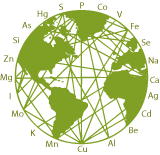Antimony - Facts about toxicity
Antimony (Sb) is naturally present in the earth’s crust at levels of about 0.2–0.3 mg/kg (ppm), but these levels vary by location (Telford et al. 2008). It can be transported into streams and waterways from natural weathering of soil, as well as from anthropogenic sources (EPA 1979; Mok and Wai 1990). Antimony enters the environment during the mining and processing of antimony-containing ores and in the production of antimony metal, alloys, antimony oxide, and combinations of antimony with other substances (Grund et al. 2012; Li et al. 2011).
Antimony and its compounds are among the oldest known remedies used in medicine for over 600 years and are used to treat a variety of ailments, most prominently parasitic disease such as leishmaniasis.
No toxic symptoms specific to antimony exposure have been identified. However, toxic side effects in humans following intraperitoneal, intravenous, or intramuscular injection of an antimony-containing drug have been reported, including altered electrocardiograms (EKGs), vomiting, diarrhea, and joint and/or muscle pain (Andersen et al. 2005; Dancaster et al. 1966; Lawn et al. 2006; Neves et al. 2009; Palacios et al. 2001)
Adverse health effects have also been observed in humans and animals following inhalation, oral, or dermal exposure to antimony and antimony compounds. The most sensitive targets appear to be the respiratory tract, heart, gastrointestinal tract, serum glucose, and development.
A study of NHANES participants found associations between urinary antimony levels, blood glucose levels and the risk of diabetes (Menke et al. 2016). An association between drinking water antimony levels and cancer incidences was also reported (Colak et al. 2015), but the EPA have not classified the carcinogenicity of antimony. According to EU regulations, mineral or drinking water may contain less than 0,0050 mg/L (= 5 mcg/l)
Very low levels are found in unexposed humans. The mean body burden of antimony was 0.7 mg (Sumino et al. 1975). The skin and hair had the highest levels of antimony. Blood studies indicate that antimony is found in whole blood, red blood cells and serum of exposed individuals.
There are limited information on antimony excretion following inhalation, oral, or dermal exposure. Elevated blood, urine, and fecal levels of antimony indicate high exposure to antimony. Increased levels of urinary antimony have been noted in workers exposed to antimony trioxide (Cooper et al. 1968; Ludersdorf et al. 1987). In animals, inhaled antimony is excreted via the urine and feces. Some of the fecal antimony may represent unabsorbed antimony that is cleared from the lung via mucociliary action into the esophagus to the gastrointestinal tract. Antimony absorbed from the gastrointestinal tract appears to be excreted in the urine and feces to a variable degree, depending on the chemical form.
Agency for Toxic Substances and Disease Registry (ATSDR). 2019. Toxicological profile for Antimony. Atlanta, GA: U.S. Department of Health and Human Services, Public Health Service.
